Eaton acquired Hayward
in 2005 (which included the Hayward acquisitions of Loeffler [’98] and GAF
[’99]) to establish an industrial filtration division. Subsequently
they acquired Ronningen-Petter®, Internormen Technology®
and Begerow® filtration among others to build the most diverse
industrial filtration product offering in the world. One of the
consequences of all these acquisitions is the difficulty of comparing an
overlap of similar products in addition to improved designs based upon new
manufacturing technology. In the case of Eaton’s bag filtration
product line, they have several similar products which can be used for the
same application, so how does one figure-out the “best” design for their
application?
You can read the sales literature to identify the
nuances of each design, make a chart and figure it out for yourself, but I
thought I’d make it easier with this article comparing Eaton’s PROLINE and
MAXILINE models of multiple bag filter housings.
What is a multiple bag filter housing?
A bag filter housing is a pressure vessel
designed to contain a disposable fabric media for filtering from 1 to 800
microns. The filter media are referred to as filter bags or sometimes
filter socks because like a bag or sock only one end is open. Dirty
fluid enters through the open end and particles get caught within the filter
bag material with only “filtered” fluid passing through. A multi-bag
filter housing contains anywhere from 2 to 24+ individual filter bags.
Each filter bag has a certain flow rate capacity, so using one vessel
containing multiple bags enables fine filtration of higher flow rates.
Eaton offers two basic multi-bag filter housings
called PROLINE and MAXILINE. The relatively new PROLINE takes
advantage of advanced manufacturing techniques to provide an economical
alternative to the MAXILINE style bag filter housings. Specifically,
the PROLINE series uses investment cast dished heads and internal tube sheet
assembly to reduce costs and welding procedures. PROLINE bag filter
vessels are a viable alternative if your application:
-
has a flow rate of up to 1000 GPM with an operating pressure ≤ 150 PSIG
-
is compatible with 304 stainless steel
-
does not require an ASME U code stamp
PROLINE bag filter housings hold three to eight
#2 size filter bags which are 7” diameter by 32” long. Nominally rated
versions of these filter bags each have a flow rate capacity of about 132
GPM and that’s how we end-up with an approximate 1000 GPM flow range at
pressures up to 150 PSIG. The maximum capacity of #2 size filter bags is
affected by the bag’s efficiency (nominal or absolute rated), viscosity and
perhaps even the particulate load. When we assist with an application,
we take such factors into consideration to recommend the appropriate number
of bag filter chambers.
The PROLINE series of bag filter housings
(available in 3, 4, 6 and 8 chamber designs) was developed in 2012 by Eaton
to fill the need for an economical bag filter housing which does not require
an ASME code stamp, because most applications do not require stamping.
Until the PROLINE, bag filter housings were made from fabricated dished
heads and filter bag chambers, labor-intensive processes involving lots of
welding and non-destructive examination procedures which contribute to the
cost of the vessel. PROLINE vessels use cast components to reduce
welding and polishing procedures along with generating less material waste.
Cast dished heads can provide the required structural integrity for the
design pressure of 150 PSI with less material. Such components are not
covered in ASME code stamped requirements and thus these cannot be ASME code
stamped.
PROLINE bag filters share the same
characteristics of the MAXILINE vessels to reduce filter bag change-out
times and personnel safety hazards.

PROLINE bag filter housings are made of 304
stainless steel in both in-line and loop flow path configurations.
Both MAXILINE and PROLINE bag filters have their outlet nozzle mounted
tangentially to the dish shaped bottom, minimizing the vessel height in
support of comfortable ergonomics and reduced risk of injury when removing
full filter bags because ladders and stools are not required.
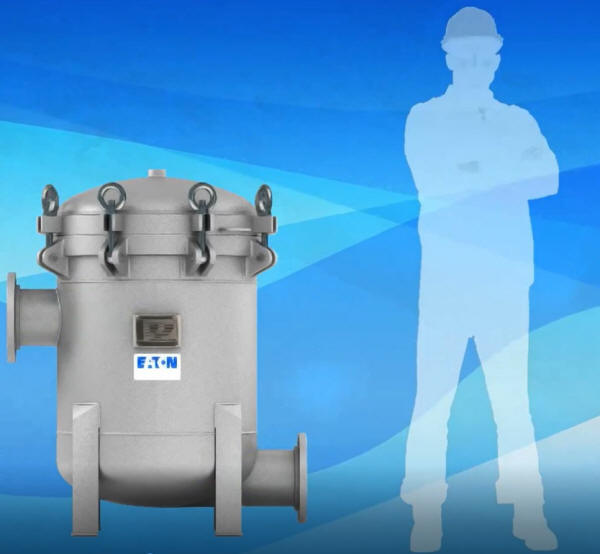
They also both have a swing eyebolt closure
(rated for pressures up to 150 PSIG at 200°F.), enabling quick access to the
filter bags, generally within 1-2 minutes, and provides a firm seal with
minimal effort. The spring assisted counter weight closure of both
MAXILINE and PROLINE enable one handed opening and it remains at any
position for safer access to the filter bag chamber.
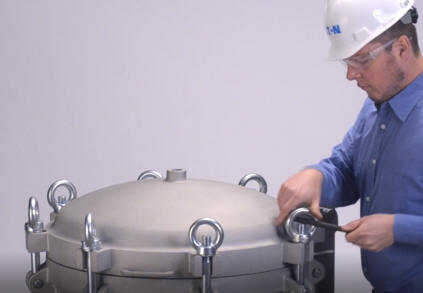
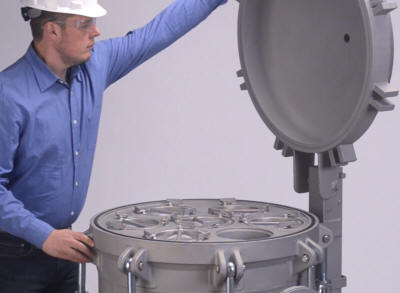

PROLINE bag filters are compatible with industry
standard #2 size filter bags and a three-point hold-down ring ensures
positive downward sealing of the filter bag to the restrainer basket.
Both PROLINE and MAXILINE bag filters can be used
in conjunction with displacement balloons, filter bag positioners and
magnetic bars.
The special features of MAXILINE bag filter
vessels include additional materials of construction, quick-opening clamp
style covers and higher flow rates.
MAXILINE bag filter vessels are available in
carbon steel, 304 SS and 316SS as well as more exotic materials for
aggressive liquids. The MAXLINE bag filter vessels can have up to (24)
#2 size bag filter chambers in support of flow rates of approximately 3,170
GPM of water-like liquids filtered with nominally rated filter bags.
Due to the way they are manufactured, MAXILINE bag filters can have an ASME
U-code stamp if that is required for your application.
The MAXILINE series consists of (5) models, each
having a specific type of closure as dictated by the requirements of your
application. As with PROLINE vessels, MAXILINE bag filter vessels are
available with Buna-N, EPDM, Viton or Teflon o-rings.
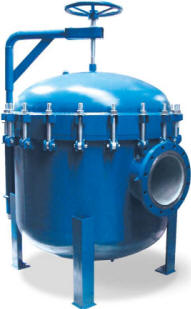
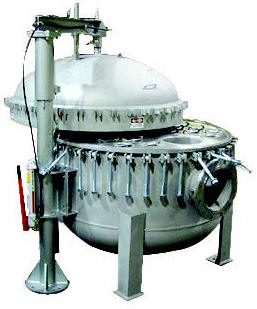
The MAXILINE HD has a swing bolt closure lifted
by a hand wheel driven lifting davit, a requirement for filter housings
having 14+ filter bag chambers because the closure for housings that large
is too heavy for spring assisted hinged closures used by the other vessels.
Available in both 304 SS and carbon steel materials, its custom fabricated
design enables customizations such as oversized inlet/outlet nozzles.

The MAXILINE HE has a swing bolt closure but
instead of a lifting davit it has the aforementioned counter weighted spring
assisted hinged cover which self-balances such that at any position it
remains where you leave it; a safety feature to prevent the chamber cover
from falling onto an employee. The MAXILINE HE hinged style can only
be used for housings with up to eight filter bag chambers because the covers
for larger units are too heavy.

MAXILINE SE has a quick-opening closure; instead of swing bolts, it has a
clamp style open/closed by a manually operated hand wheel. To actuate the
hand wheel the operator must first disengage the vent valve, a safety feature to
ensure the vessel is depressurized prior to opening the cover. Eaton refers to
this as their Qic-Lock™ closure and it is specifically engineered to reduce both
the access time and risk of injury to personnel. As with the other
designs, the counter weighted spring assisted hinge simplifies access to the
filter housings 3 to 12 chambers.
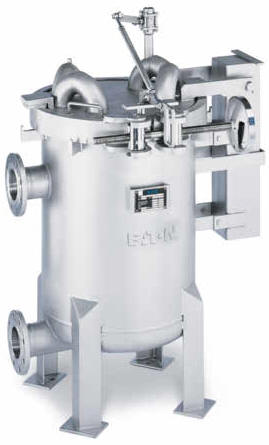
The other two MAXILINE variations have chamber covers designed to seal
directly against the filter bag sealing ring, improving the sealing efficiency
for applications requiring 95%+ efficient retention of particles 25 microns and
smaller. These variations both have counter weighted spring assisted
hinged chamber covers, one having a swing bolt (MDE), the other with Qic-Lock™
style closure (VMDE).
Filter housing selection process
The first step is reviewing the flow rate requirements corrected for both
viscosity and intended particle retention size to determine the number of filter
bag chambers required; if it exceeds (12) then the only option we offer is the
MAXILINE HD.
The next criteria to consider is the fineness of filtration required and
whether the filter bag required has a specific >95% efficiency or if it is a
common, nominally rated design. High efficiency applications require the
crush seal style SENTINEL RING™ and benefit immensely from a filter bag closure
whose cover seals directly against the filter bag, the MAXILINE MDE or VMDE.
Nominally rated filter bag applications can be satisfied with one of the
other PROLINE or MAXILINE vessels based upon the aforementioned
characteristics. The next time you have a filtration application reach out to us
and we will put our experience to work for you!





